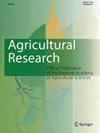This experimental study was conducted to augment farm productivity and possibly reduce the interface of farmers and pesticides. The pilot study explored scalable and sustainable agricultural techniques by an adoption of specific precision agriculture features which can improve the hunger-index of tribal families whose livelihoods are farming of arid lands. The study engineered, executed and evaluated the field experiment and gathered data (time series) associated to two water intensive crops Paddy and Cotton in the Kharif Season over one crop cycle (6 months) spanning 108 square kilometers of hostile and arid tribal land by the deployment of an Artificial Intelligence (AI) powered Unmanned Arial Vehicle (UAV). This calibrated UAV performed automated optical sensing and intelligent planning options apart from data collection which was subjected to 3D spectral analysis and derive functions of Leaf Area Index Curve Fit Models, Logistic and S-Curve functions. The schematics embedded in the UAV were re-designed and iterated to obtain ordinal data that was classified into hyperspectral information by way of a k-means algorithm to function as a text stream cluster based on adaptive feature selection. The study endorsed that Object Based Image Analysis with algorithms of AI asymptotically can derive yields that was previously thought of as impossible. The study also reinforces that conjoining UAV technology and transportation science can address challenges across the commercial spectrum in an analytical and portable pattern by looping the routing and scheduling path (fixed interval repetition) of UAV’s which is of paramount importance and unique to this current study.



